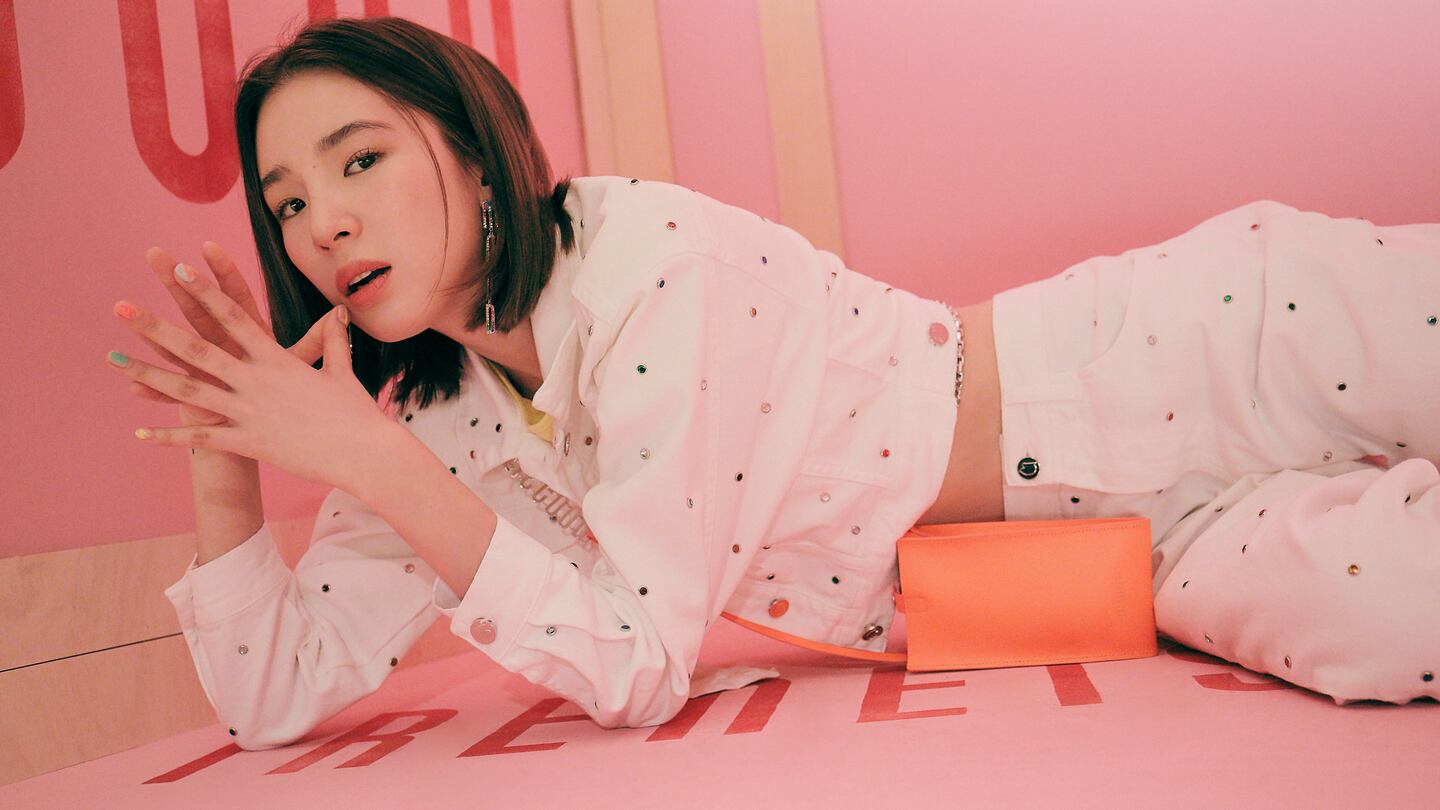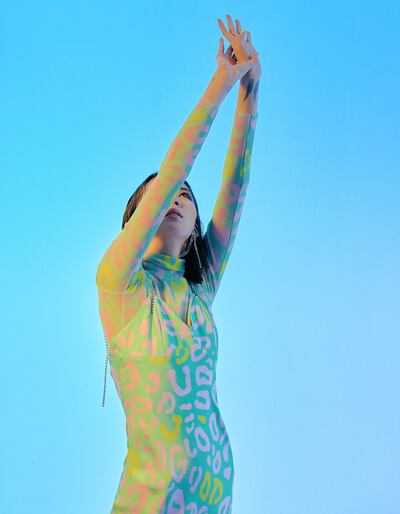
The Business of Fashion
Agenda-setting intelligence, analysis and advice for the global fashion community.

Agenda-setting intelligence, analysis and advice for the global fashion community.

NEW YORK, United States — Irene Kim's 1.7 million Instagram followers tune in to see her document Valentino's latest collection from the front row or pose with the Blackpink pop stars Rosé and Lisa at fashion parties.
So when Kim took a rare break from fashion week last year, the absence did not go unnoticed.
"Everyone was like… where is Irene?" said Kim, a Korean-American model-turned-influencer known for her multi-coloured "unicorn" hair. "Just because I don't post for a week doesn't mean that I'm not doing anything."
Here’s what Kim was doing: she was in Seoul, preparing to launch a label of ready-to-wear and accessories. She’s calling it Irene is Good, just like her Instagram handle. The first collection, featuring bright colours, optimistic messages and shiny unicorn symbols, debuts in February with Farfetch and Galeries Lafayette, with rollouts planned to other retailers.
ADVERTISEMENT
Kim is the latest social media personality to put her influence to the ultimate test by creating her own brand. It's a crucial career step that can unlock fame and riches far beyond what social media stars earn from promoting other brands' products. Influencer brands now sell out at Sephora and Nordstrom. Kylie Jenner sold her makeup brand at a $1 billion valuation to Coty.
Success is not guaranteed. Last year, beauty blogger Jacyln Hill struggled to launch her makeup line, which had product deficiencies that angered fans. Instagram star Arii shut down her fashion line after just two weeks when it failed to hit a minimum sales target.
"You have to be able to convert [sales] at the end of the day and not everybody can do that," said Jennifer Powell, the founder of an influencer management and brand-building agency. "There is a real come-to-Jesus moment within an influencer's life, to know if they can really convert."
There is a real come-to-Jesus moment within an influencer's life, to know if they can really convert.
In many ways, the recipe for a successful influencer brand is similar to any other new business in fashion and beauty: the brand needs to have a clear and differentiated point of view, offer a product that satisfies customers and dependable customer service and delivery.
Nicolette Mason, an influencer and consultant, co-founded a plus-size clothing range, Premme, in 2017 and closed it two years later. She said influencers need to think carefully about why their brands need to exist.
“It’s become a status symbol for influencers to have their own brand or product line or collaboration, and I think there needs to be an existential question of: is this something people really need? Is this filling a real void?” she said.
Those voids are fewer and far between, now that influencer-backed brands exist for everything from swimwear (from Instagram's Danielle Bernstein and Emily Ratajkowski) to coffee (from Youtube's Emma Chamberlain) to lashes (from reality TV's Lilly Ghalichi).
Read on for advice about how to launch an influencer brand in 2020.
ADVERTISEMENT
1. Test the Market
Nearly two years before launching a full collection, Kim started the Irene is Good brand by releasing T-shirts and a clear PVC tote and cosmetics bag. Embroidered hoodies and more low-price, playful accessories followed in early 2019. Many items started at just $15.
Around this time, Vittorio Cordella, the founder of sneaker line Joshua Sanders, approached Kim about scaling her business at a higher price point. The two had already worked together, including collaborating on a line of $370 shoes in 2018 that Cordella said had sold out.
For Kim to graduate from T-shirts to contemporary ready-to-wear, Cordella connected the influencer with Mofra, an Italian company that partnered with mega-influencer Chiara Ferragni on her namesake line. Together they formed a new parent company for Irene is Good with Mofra, Kim and Cordella as shareholders (Kim owns the largest stake). Cordella signed on as vice president of merchandising, product development and sales.

Irene Kim models her namesake line | Source: Se Hyung Lee @biglipkid
The goal is for Kim’s sales this spring to reach 10 times where they were when the partnership began. Those early years were crucial to forming a brand identity, building awareness and earning press recognition, such as when K-pop stars wore her pieces. By selling via her own website, Kim also proved her global appeal to future wholesale partners: the US is her biggest market, followed by Korea, Hong Kong and Taiwan.
“I just didn't want to use my name as an influencer and then launch a brand,” said Kim. “I wanted it to live on its own and get the credibility and the respect of my followers and the industry.”
2. Determine the Key Category, Price Point and Point of View
ADVERTISEMENT
Powell recommends influencers collaborate with brands before starting their own lines. These lower-risk projects test an influencer’s ability to sell in different product categories and price points and gather customer data.
Influencers should stick with products that tie into their core content, at least at the start, said Daniel Landver, co-founder and chief executive of Digital Brand Products, part of influencer management company Digital Brand Architects. A beauty influencer should not start by launching a home brand, for example.
Max Stein, founder and chief executive of creative management agency Brigade Talent, said an influencer’s launch products need to be “niche but endemic." Start with a sub-category, such as a sweater or jacket, that will instantly resonate with followers, rather than attempting to go after the fashion mainstream right off the bat.
“If you launch a whole clothing brand, your competitors are Kate Spade and Club Monaco and Revolve," he said.
3. The Pros and Cons of Partners
For their first line, an influencer might sign a majority stake of their brand to an operator, which puts up the cash needed to get off the ground and handles product development, production, logistics and delivery. The influencer focuses on marketing, and though they may receive a salary, they might not even own their own trademark.
An influencer with a proven ability to sell products may play a bigger role and receive a greater share of the profits. They can also opt instead for a licensing agreement, where a partner receives temporary rights to create products using an influencer's name. The influencer retains ownership of his or her brand and receives a percentage of sales. Goop’s first skincare products, for example, were developed by partner Juice Beauty.
The danger is that partners might see launching an influencer brand as an opportunity to make a quick buck, rather than something to build over the long term, said Mason, the influencer and consultant.

Irene Kim models her namesake line | Source: Se Hyung Lee @biglipkid
“I think a lot of people get stuck in this rush to put things out and enter the sales cycle,” she said. “It’s better to wait and get it right.”
The wrong partner can also produce inferior products, hurting an influencer’s reputation.
"You are putting your entire reputation on the line when you are endorsing something," said Chris Gay, co-chief executive of Elite Model Management and president of The Society, which represents Kim.
The nature of these partnerships can evolve. WeWoreWhat’s Danielle Bernstein had several hit collaborations with swimsuit maker Onia before the two signed a multi-year licensing agreement to create a WeWoreWhat swimsuit brand.
“Both sides have data at that point and you are walking into something with everybody’s eyes wide open,” said Powell.
4. Balance New and Old Businesses
Influencers need to prepare for some of their reliable sources of sponsored posts to dry up when they launch a brand of their own.
Brands that once eagerly flew an influencer to fashion shows in exotic locations might stop calling once he or she becomes a competitor.
“A lot of the brands were very sceptical of what I was doing and I just took that risk,” said Kim. “They thought, oh, so is she not being an influencer anymore?”
Maintaining an Instagram feed that includes sponsored posts, plugs for a personal brand and non-commercial content is also a challenge. If the balance tilts too heavily in any one direction, it can alienate followers.
“It’s important to maintain your organic content and be impartial, so you’re not just promoting your own brand,” said Mason.
Kim said she has pulled back on sponsored one-off Instagram posts, focusing instead on her long-term partnerships with brands like Chanel.
“I was very careful about promoting too much of other brands because I was getting so commercialised,” she said.
Kim is also limiting how she talks about her own brand on her personal Instagram account. For example, she posts personal messages in the captions on her own feed, and saves more-overt marketing for the Irene is Good account.
“I don't want to throw it in people's faces,” she said.
5. Pick the Right Retail Partners
Kylie Jenner built a cosmetics empire by selling directly to consumers on her own website before partnering with Ulta. Most influencers still need a retailer to drive sales and help with marketing at launch. These tie-ups provide validation, a marketing boost and a place for influencers to meet followers in real life.
Cordella said he and Kim sought out retailers that can host pop-ups or set up shop-in-shops.
“It’s the offline experience that counts right now,” he said. “We wanted to give a real experience with Irene’s fans.”
In February, Galeries Lafayette Champs-Élysées will set up a dedicated space for Kim’s line, designed with bright pink modular furniture to look like a dream version of her closet. She will host an event there with Korean nail artist Eun-Kyung Park, who is known as Unistella.
“You are entering our office, our world,” Cordella said. “You need to see what is behind the clothes."
Related Articles:
[ The New Rules of Influencer MarketingOpens in new window ]
[ Fuelling the Influencer Machine: The Hidden Network Turning People Into StarsOpens in new window ]
Well, not exactly. But some surprising names made an impression on the red carpet alongside the likes of Loewe, Alaïa and Balmain.
The designer — whose bright, arty clothes earned him a place in the 2021 LVMH Prize Finals, and a guest designer post for Louis Vuitton — curated a set at the Netflix Is a Joke Festival this weekend, the latest example of his creative approach to building brand awareness.
Practitioners of this historically behind-the-scenes profession are building powerful followings, riding a wave of interest in how the fashion sausage is made. But even the highest-profile PRs caution that the client still has to comes first.
Join us for a BoF Professional Masterclass that explores the topic in our latest Case Study, “How to Create Cultural Moments on Any Budget.”